In the realm of music production and audio recording, the importance of a reliable audio interface cannot be overstated. Acting as the bridge between the digital world of your computer and the analog environment of microphones and instruments, an audio interface is essential for capturing high-quality sound.
For those working with software like Logic Pro X, the interface becomes even more pivotal, given the software’s advanced capabilities and professional-grade demands. This article delves deep into the world of Thunderbolt audio interfaces, known for their rapid data transfer speeds and superior reliability. We’ll explore their salient features, why they are worth considering for your setup and dive into the best Thunderbolt audio interface for Logic Pro X.
Whether you’re an established music professional or just dipping your toes into the ocean of audio production, this comprehensive guide is tailored to give you a clear overview of Thunderbolt audio interfaces and their indispensable role in contemporary sound recording.
Related: Best Podcast Mixers
Contents
Best Thunderbolt Audio Interface For Logic Pro X
Making music with Logic Pro X? You’ll want an audio interface that complements its capabilities and delivers top-tier performance. Let’s dive deep into some of the best Thunderbolt audio interfaces out there.
PreSonus Quantum 2626
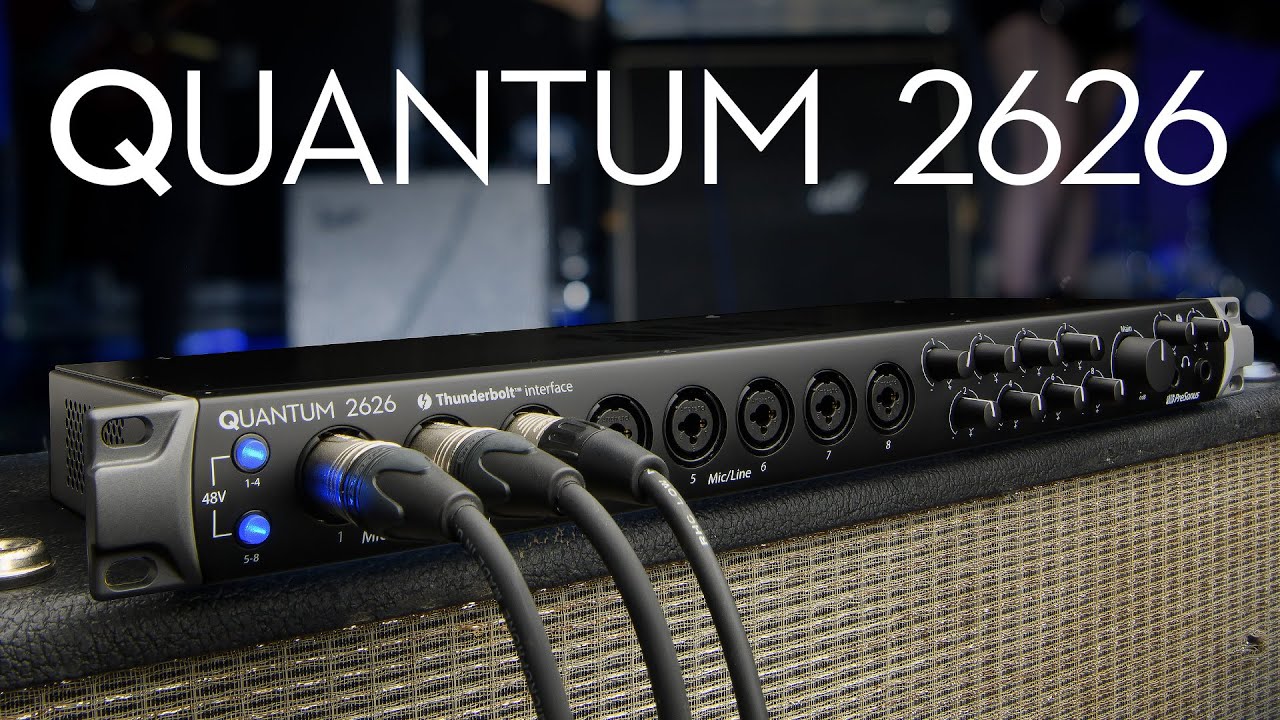
Quantum 2626 features 26×26 Thunderbolt 3 ultra-low-latency (as low as <1 ms roundtrip). Image Source.
Entering the arena with blazing speed and impeccable clarity is the PreSonus Quantum 2626, a powerhouse that redefines the boundaries of what an audio interface can accomplish. With its emphasis on providing ultra-low latency through the Thunderbolt 3 connectivity, the Quantum 2626 doesn’t just record sound—it captures the very essence of the audio. Thanks to its 24-bit 192 kHz converters, every recording promises to mirror the source with surgical precision, ensuring that the resulting tracks are as authentic as the live sound.
However, speed and clarity are just the beginning. What sets the Quantum 2626 apart is its commitment to versatility. It’s equipped with a plethora of input and output channels, designed meticulously to cater to every recording need. Be it a multi-instrumental session or an intricate podcast with multiple speakers, the Quantum 2626 stands ready to accommodate.
Furthermore, its expandability, via dual ADAT inputs, ensures that as your studio grows, the Quantum 2626 grows with it, remaining a steadfast and integral part of your audio journey. When combined with PreSonus’ acclaimed Studio One software, this interface transforms into a complete recording solution, blending hardware prowess with software brilliance.
Key Features
- Through Thunderbolt 3 connectivity, ensuring real-time recording and playback without delays.
- Provides 24-bit 192 kHz audio conversion, capturing every detail.
- A variety of input and output channels to cater to diverse recording requirements.
- Dual ADAT inputs allow for the addition of more channels if needed.
- Designed to work flawlessly with PreSonus’ Studio One software, offering an integrated recording solution.
Pros
- Thunderbolt 3 ensures blazingly fast data transfer rates.
- Offers a wide range of connectivity options to suit various setups.
- It can grow with your studio’s needs due to its expandability options.
- Ensures that the recordings remain true to the source.
Cons
- Those without a Thunderbolt 3 port may find it less accessible.
- Optimized performance when used with Studio One, which might not be everyone’s primary DAW.
Scarlett 2i2

Scarlett 2i2’s Auto Gain sets your levels and Clip Safe keeps them in the sweet spot. Image Source.
Focusrite’s Scarlett 2i2 has earned its place in the music world due to its reliability, compact design, and exceptional sound clarity. Being one of the top-selling audio interfaces in the global market, it promises quality at an affordable price. Designed keeping in mind the needs of on-the-go musicians and podcasters, the Scarlett 2i2 not only provides top-tier sound recording but also ensures minimal latency, making it ideal for real-time recordings.
Furthermore, its red anodized aluminum chassis doesn’t just make it visually appealing but also enhances its durability, ensuring that it withstands the tests of time and travel.
Key Features
- Dual combination XLR and ¼” TRS inputs
- Powered by USB – no external power supply required
- High-quality mic preamps
- Direct Monitoring
Pros
- User-friendly interface
- Durable and portable
- Excellent audio quality
Cons
- Limited inputs and outputs for larger setups
- Might need an additional power source for certain microphones
Apogee Element 24
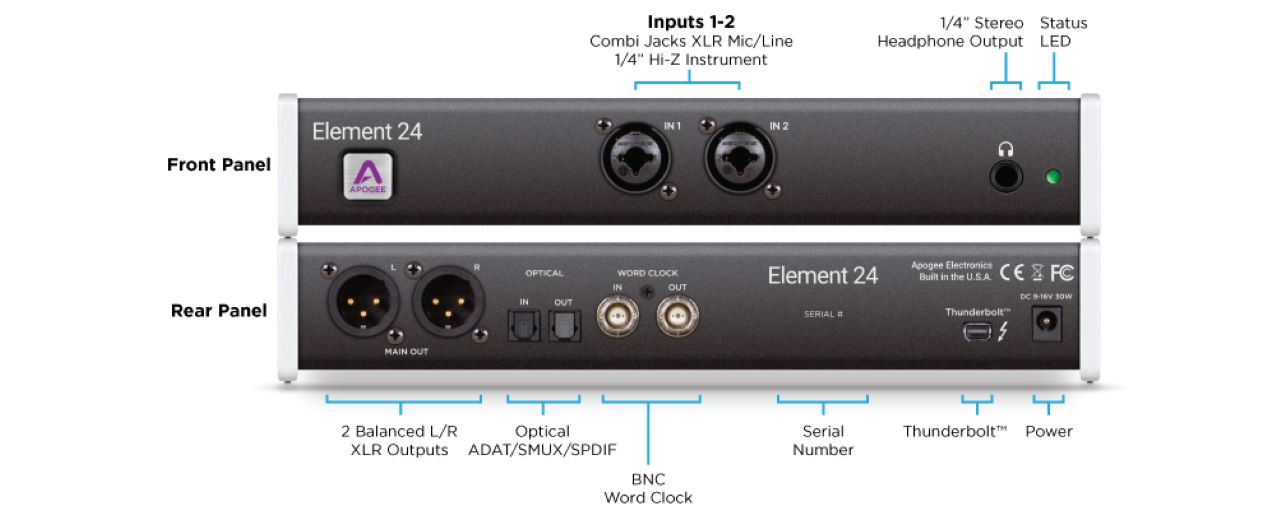
The Apogee Element 24 highlights 10 IN x 12 OUT Thunderbolt Audio I/O box. Image Source.
When it comes to high-fidelity sound and a clutter-free setup, the Apogee Element 24 shines. Apogee’s legacy of producing top-notch audio equipment resonates well with this model, ensuring professional-grade sound quality. The minimalist design of the Element 24 might deceive some, but underneath that compact frame, it packs a considerable punch in terms of performance.
The clarity of audio and depth of sound it captures, paired with the ease of integration with Mac systems, makes it a go-to choice for many professionals and enthusiasts who prioritize quality over bells and whistles.
Key Features
- 10 IN x 12 OUT Thunderbolt audio I/O box
- Single port Thunderbolt connectivity
- AD/DA conversion for recording up to 192kHz/24-bit
Pros
- Superior audio clarity
- Compact and efficient design
- Seamless integration with Mac
Cons
- No built-in MIDI
- Premium price point
Solid State Logic 2+

The SSL 2+ features a 2 x SSL-designed microphone preamps. Image Source.
Solid State Logic, known for its high-end mixing consoles, brings studio-level quality to your desktop with the SSL 2+. This interface provides a balance between professional-grade quality and a user-friendly design.
With its legendary 4K analog enhancement, users can infuse warmth and a vintage vibe into their recordings, reminiscent of classic SSL consoles. This best audio interface also offers a high-fidelity listening experience along with amazing sound quality thanks to its professional-grade headphone output and high-current delivery.
Key Features
- 2-In/4-Out USB-C Audio Interface
- Legacy 4K – analog color enhancement
- High-performance mic preamps
Pros
- Robust build quality
- Pristine sound capture
- 4K analog enhancement offers versatility
Cons
- Limited I/O for larger recording setups
- USB-C may require adapters for some setups
Scarlett OctoPre

The Scarlett OctoPre features eight natural-sounding 2nd generation Scarlett mic preamps. Image Source.
With the Scarlett OctoPre, Focusrite brings an extension powerhouse to your audio setup. Designed to provide eight additional channels to your recording interface, it’s the solution for those who find themselves frequently running out of inputs. Ideal for larger recording setups, such as full-band recordings or miking up a drum kit, the OctoPre ensures that every sound is captured with the utmost clarity.
Its combination of pristine preamps and flexible connectivity options ensures that it seamlessly integrates into your existing setup while elevating the overall recording quality.
Key Features
- 8-channel mic pre expansion with ADAT
- Eight natural-sounding 2nd generation Scarlett mic preamps
- Two instrument inputs
Pros
- Great for expanding current setups
- Crystal clear sound quality
- Versatile use-case scenarios
Cons
- Might be overkill for solo musicians
- Requires separate power supply
Audient iD4
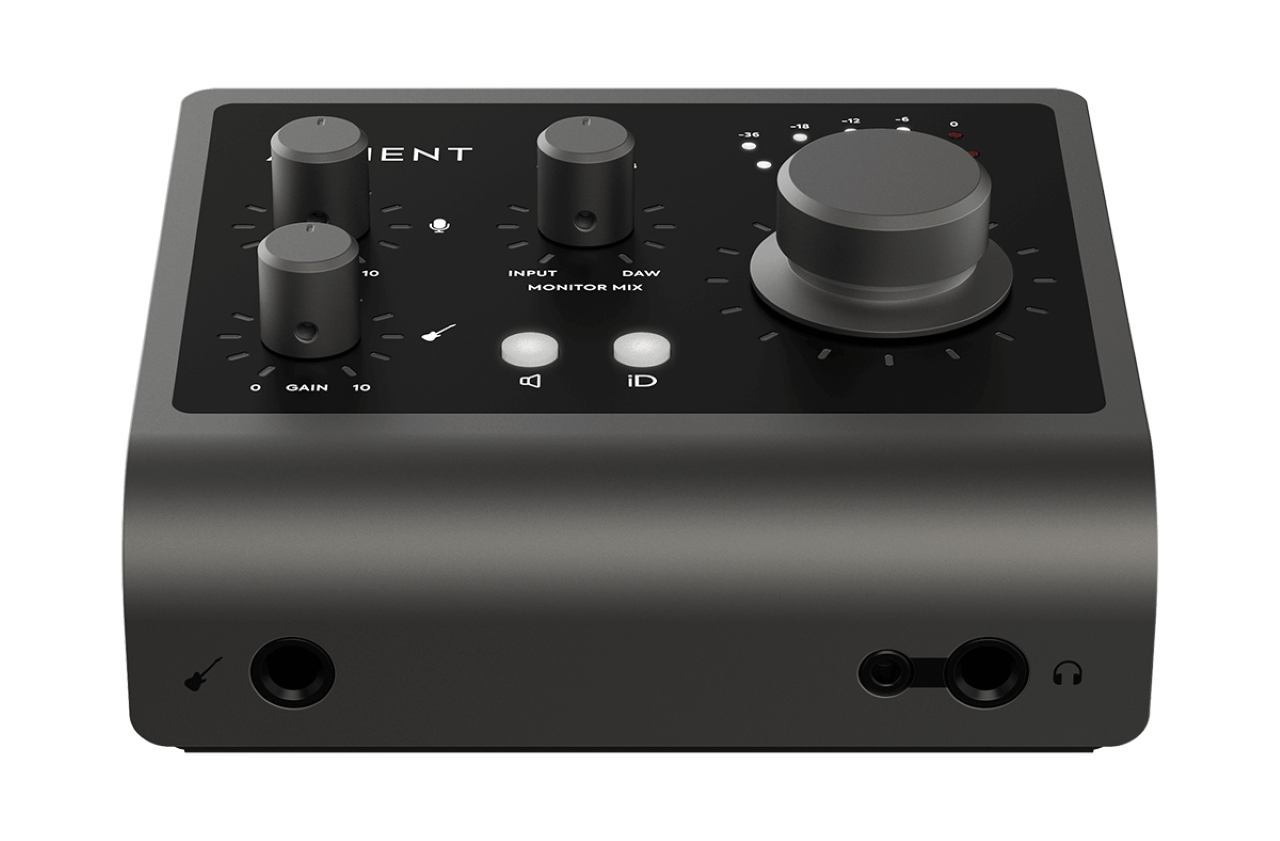
iD4’s Audio Loop-back feature can be configured via its own dedicated Audio Loop-back Mixer software. Image Source.
Compact yet brimming with features – the Audient iD4 is a reflection of what modern audio interfaces should be. With its impeccable AD/DA conversion, it guarantees that every nuance of your audio is captured faithfully.
The iD4 is not just about recording; its ScrollControl feature turns the iD4’s volume encoder into a virtual scroll wheel, allowing creative control within your DAW and making parameter adjustments more intuitive. Whether you’re sketching out ideas or recording final takes, this professional audio interface promises consistency and quality.
Key Features
- Class-leading conversion and sample rates up to 96kHz / 24-bit
- ScrollControl
- Monitor Mix & Pan
Pros
- Exceptional sound clarity
- Compact and rugged build
- User-friendly control set
Cons
- Limited I/O for larger recording projects
- No MIDI in/out
Apollo Twin MkII
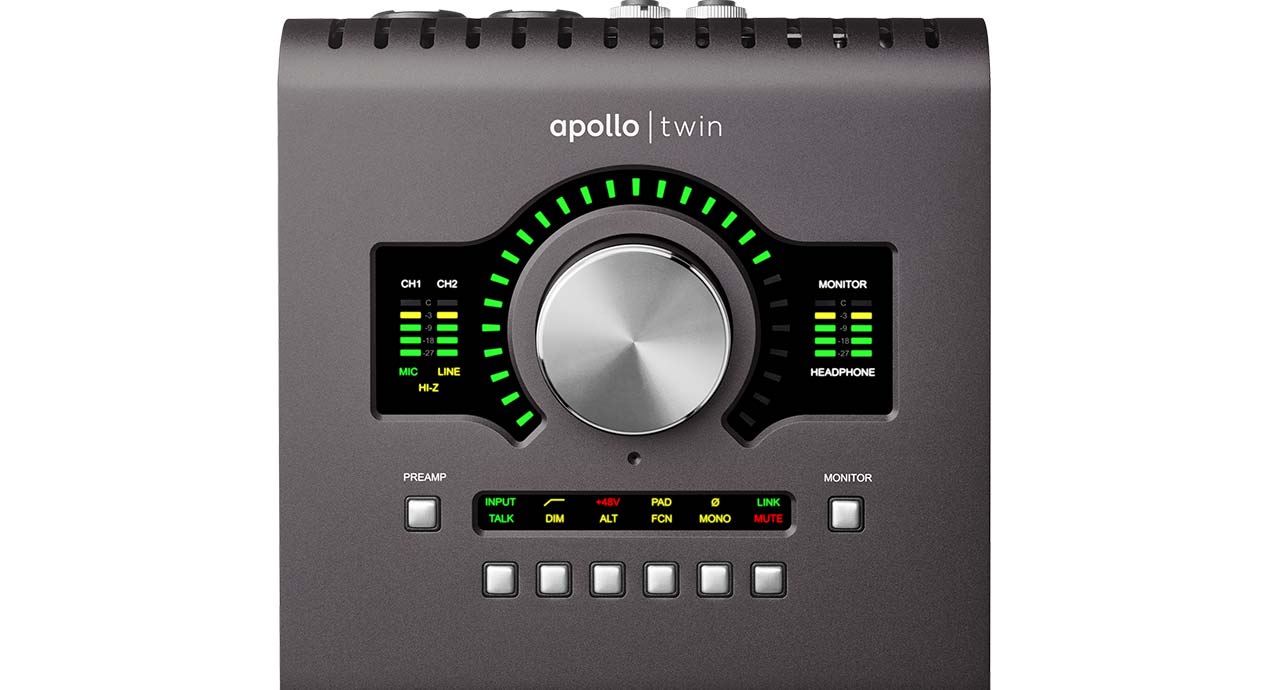
Apollo Twin MkII features two Unison-enabled mic preamps, letting you track through exacting mic preamp emulations from Neve, SSL, API, Manley, and Universal Audio. Image Source.
Universal Audio’s Apollo Twin MkII stands tall as a testament to what an audio interface can achieve in the right hands. Famed for its Realtime UAD Processing, the Apollo Twin MkII allows for near-zero latency tracking with UAD plugins, ensuring professional sound quality and flexibility.
Its Unison technology is a game-changer to record audio, offering stunning emulations of classic tube and transformer-based preamps. This portable audio interface isn’t just a tool – it’s an experience, bridging the gap between vintage analog warmth and modern digital clarity.
Key Features
- Realtime UAD Processing
- Unison technology for classic tube and transformer-based preamps
- Built-in talkback microphone
Pros
- High-end AD/DA conversion
- Solid build quality
- The wide array of plugins and integration
Cons
- Premium price tag
- A limited number of free UAD plugins
Behringer U-PHORIA UM2
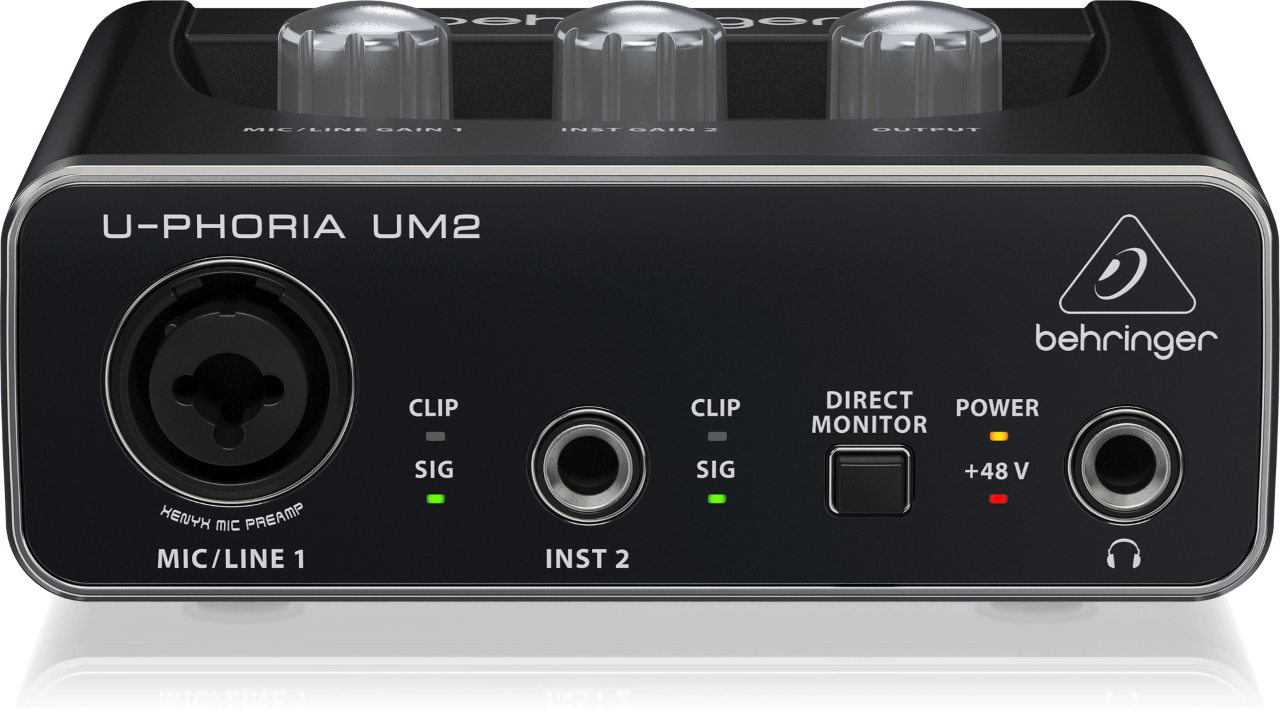
UM2 offers 2×2 USB audio interface for recording microphones and instruments. Image Source.
The Behringer U-PHORIA UM2 is proof that you don’t need to break the bank to start recording. Ideal for beginners and those looking for a simple setup, the UM2 provides the essentials without the frills. Its XENYX Mic Preamp captures audio with clarity and precision, ensuring that your recordings are crisp.
Designed with simplicity in mind, it allows even the most novice of users to start their recording journey without a steep learning curve.
Key Features
- 2×2 USB audio interface for recording microphones and instruments
- XENYX Mic Preamp
- Direct monitor function
Pros
- Highly affordable
- Compact and easy to use
- Suitable for basic recording setups
Cons
- Not the best for high-end studio setups
- Build quality isn’t as robust as some competitors
Focusrite Scarlett 8i6 3rd Gen
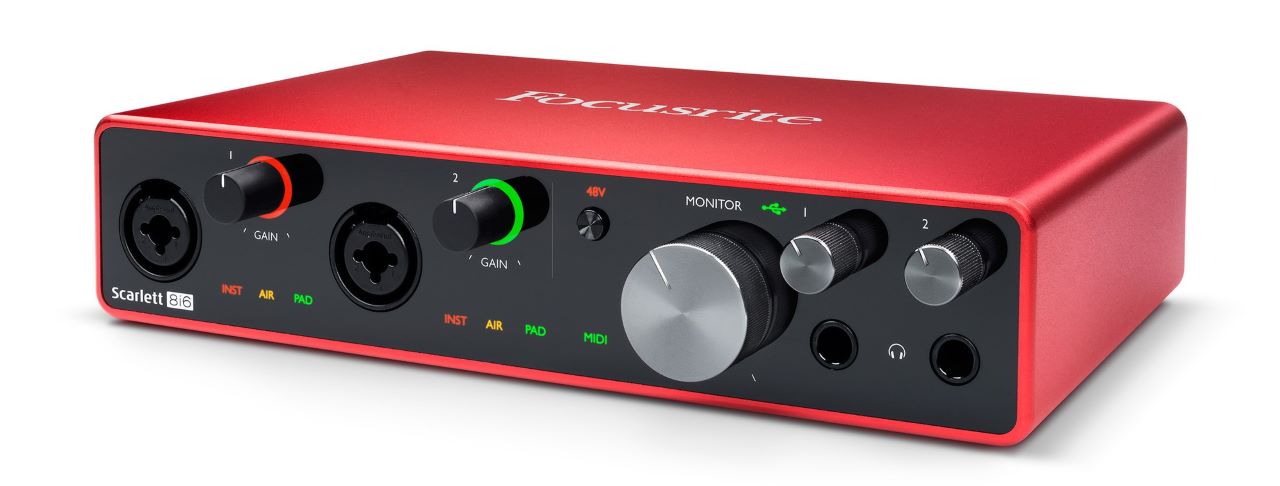
The 8i6 3rd Gen offers USB-C connectivity, compatible with MacOS and Windows. Image Source.
Expanding on Focusrite’s esteemed Scarlett series, the 8i6 3rd Gen offers a more advanced solution for those in need of a versatile audio interface. With more input and output options like most audio interfaces, it’s designed for those whose recording needs exceed the basics.
From podcasters who require multiple mic setups to musicians recording several instruments simultaneously, the 8i6 ensures every sound is captured flawlessly. Its intuitive control software allows users to customize their setup, ensuring that every recording session can be tailored to perfection.
Related: Focusrite Clarett vs Scarlett
Key Features
- 8-in, 6-out USB audio interface
- Dual Scarlett mic preamps
- Loopback functionality for podcasts and live streaming
Pros
- Expanded I/O for versatile recording setups
- Robust build quality
- Superior sound clarity
Cons
- It might be overkill for basic setups
- Requires an external power source
M-Audio M-Track Duo
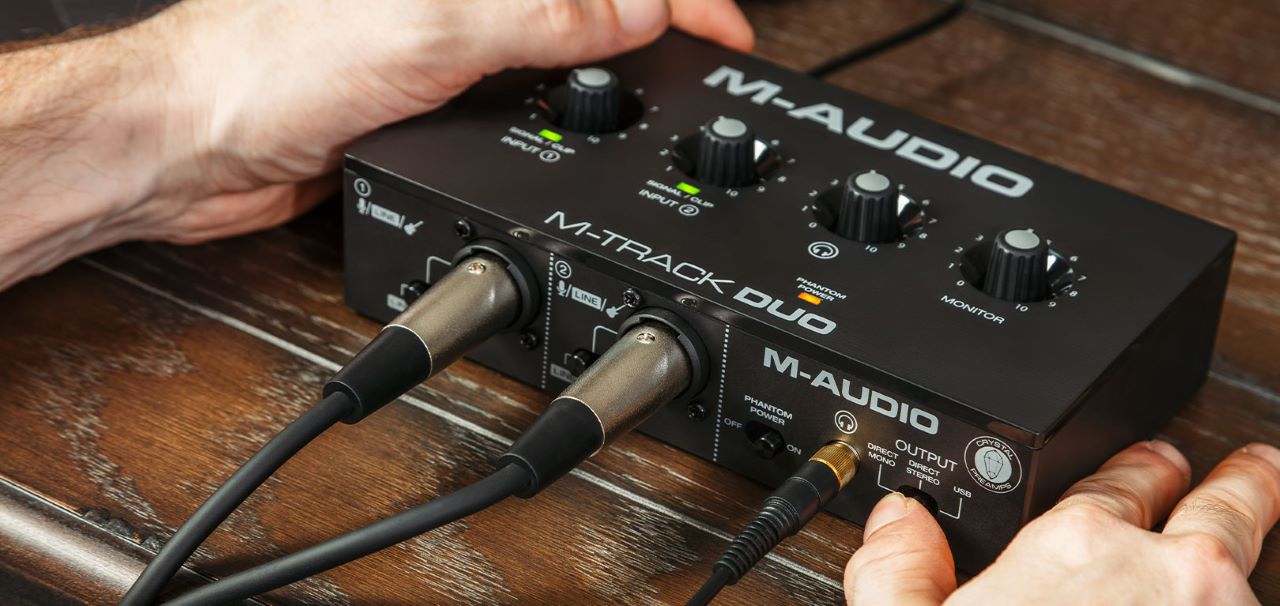
The M-Track Duo offers 2-Channel USB recording interface for Mac and PC. Image Source.
For those just embarking on their musical journey, M-Audio’s M-Track Duo presents an excellent starting point. With the backing of M-Audio’s reputation for crafting reliable audio equipment, the M-Track Duo is designed to be straightforward and efficient, catering especially to those new to the world of digital audio recording.
Its sleek design conceals a powerful interface that guarantees professional audio quality. Whether you’re laying down vocal tracks, recording instruments, or podcasting, this compact tool ensures that every sonic detail is captured with precision.
Additionally, M-Audio understands the requirements of the modern artist. The M-Track Duo is more than just an interface; it’s a gateway to creativity. The product packs a suite of software tools to jumpstart any project, making it an all-encompassing package for those eager to begin their digital audio exploration. It’s a testament to the fact that quality and affordability can indeed go hand in hand.
Key Features
- Two-channel audio recording
- Direct monitoring for real-time feedback
- A bundled software suite to kickstart projects
- High-quality preamps ensure clear audio capture
Pros
- Affordable
- Easy to use, perfect for beginners
- Compact and portable design
Cons
- It might be limiting for advanced users
- Limited expansion options
PreSonus AUDIOBOX USB
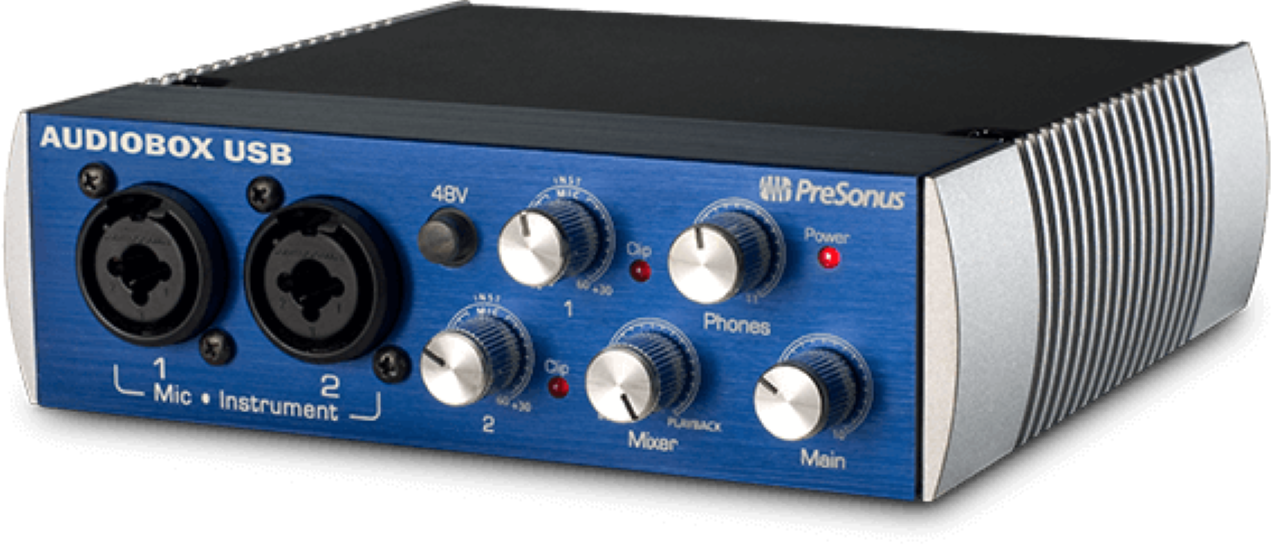
The AudioBox USB comes equipped with Studio One Artist to provide you with a complete recording solution right out of the box. Image Source.
PreSonus, a brand synonymous with top-tier audio equipment, offers the AUDIOBOX USB for those seeking reliable performance without the hefty price tag. This ruggedly built interface is as durable as it is versatile, promising consistent performance regardless of the environment. Be it a home studio setup or on-the-go recordings; the AUDIOBOX USB stands resilient. Its simplicity in design is mirrored in its user interface, ensuring that even newcomers to the recording scene can get started with minimal fuss.
Beyond its physical attributes, what truly sets the PreSonus AUDIOBOX USB apart is its impeccable audio quality. With its high-performance microphone preamplifiers, every recording is clear, detailed, and free from unwanted noise. This is paired with a rich bundle of software offerings from PreSonus, ensuring that users have everything they need right out of the box. It’s not just an audio interface; it’s a comprehensive recording solution.
Key Features
- Two combo mic/instrument inputs
- 24-bit resolution; 44.1, 48, 88.2, and 96 kHz sampling rates
- Zero-latency monitoring
- Bundled with PreSonus Studio One Artist software
Pros
- Robust build quality
- Great value for money
- Intuitive and beginner-friendly
Cons
- Lacks advanced features of higher-end models
- Not the most compact design for portability
Antelope Audio Zen
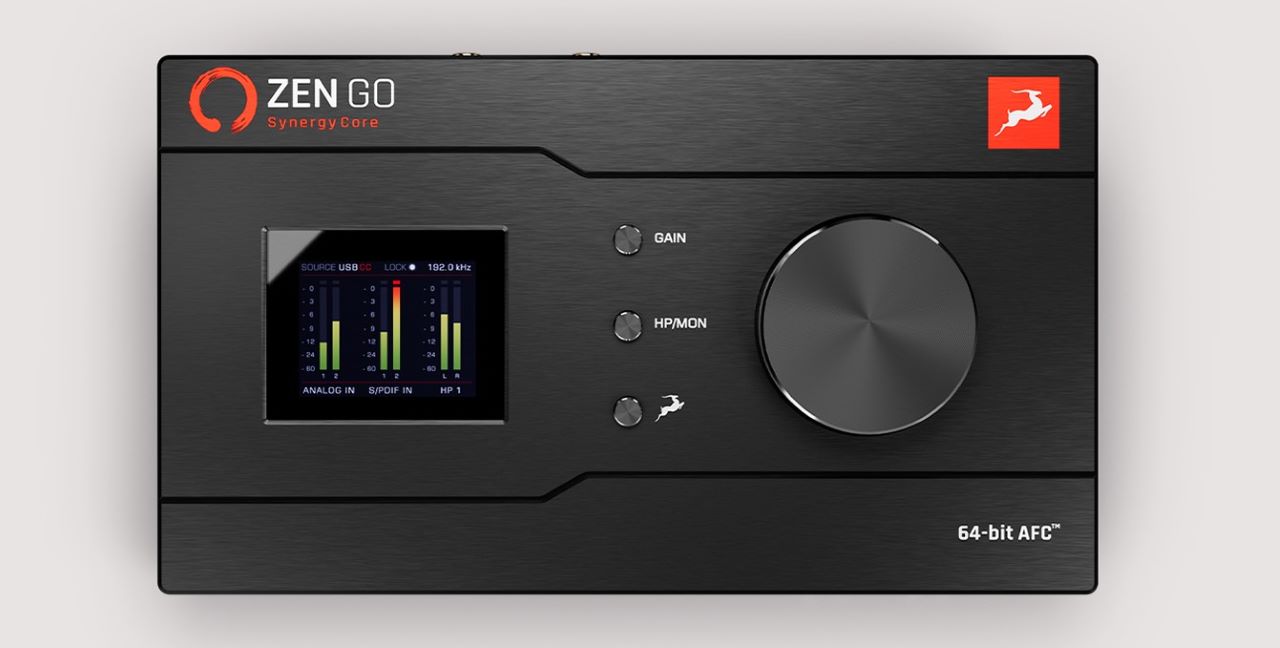
The converters offer up to 127dB of headroom and provide extended detail in the low-end. Image Source.
Antelope Audio’s Zen is not just a product; it’s an experience, a symphony of art and engineering coming together to create an auditory masterpiece. Known for its premium-grade audio equipment, Antelope Audio has crafted the Zen with an uncompromising commitment to sonic excellence. This is reflected in its high-resolution AD/DA converters, ensuring that every sound, from the subtlest of notes to the most explosive of beats, is captured with pristine clarity and unmatched depth.
Beyond its impressive technical specs, the Zen encapsulates the essence of a true artist’s tool. Its intuitive design makes it accessible to both novices and seasoned professionals, ensuring a seamless recording experience. With a robust build, it promises durability, making it a reliable companion for both in-studio sessions and on-the-road gigs. The array of connectivity options, from analog to digital, ensures that no matter your setup, the Zen integrates effortlessly.
However, what truly sets Zen apart is Antelope Audio’s revered clocking technology. With it, the Zen ensures synchronization perfection, guaranteeing that your recordings remain jitter-free and resonate with authenticity. In essence, the Zen is more than an audio interface; it’s a testament to Antelope Audio’s relentless pursuit of perfection in the realm of sound.
Key Features
- Captures and reproduces sound with precision and depth.
- Makes it easy to use for both beginners and professionals.
- Designed for durability and long-lasting performance.
- Ensures seamless integration with various setups.
- Revered technology to maintain synchronization and reduce jitter.
Pros
- Known for its pristine audio capture and playback.
- Can withstand the rigors of both studio use and touring.
- Ensures that all recordings are jitter-free.
- Even with its advanced features, it’s easy to navigate.
Cons
- It might be on the higher side for amateur musicians or hobbyists.
- Due to its robust build, it might take up more space than some of the more compact interfaces on the market.
With this comprehensive deep dive, you’re armed with detailed insights to make an informed choice about the audio interface that aligns with your musical journey’s aspirations. Remember, the best audio interfaces are the one that complements your unique needs and creativity.
Key Features To Consider In A Thunderbolt Audio Interface
Before you hit that buy button, there are some essentials to ponder. These aren’t just about getting sounds in and out of your computer; it’s about making sure that every beat, strum, or vocal note is captured with pristine clarity. Let’s jump in!
I/O Configuration
When it comes to I/O, or Input/Output configurations, there’s more to it than just plugging in and hoping for the best.
Input Channels – Number and Types (e.g., XLR, line, instrument)
Inputs, my friends, are where the magic begins. Do you need multiple channels for drums? Maybe you’re just a solo artist who only requires one or two?
- XLR Inputs: Essential for mics, especially if you’re into recording vocals or acoustic instruments.
- Line Inputs: Great for keyboards or synths.
- Instrument Inputs: Plugging in your guitar or bass? This one’s for you!
Which type do you see yourself using the most? Having a mix can be beneficial.
Output Channels – Monitor Outputs, Headphone Outputs, and More
Once your music is inside the computer, you’ve got to hear it, right? That’s where outputs come in!
- Monitor Outputs: For those big, beautiful studio speakers.
- Headphone Outs: Essential for late-night sessions or when you just want to get lost in the mix.
Expandability – ADAT, S/PDIF, and Other Expansion Options
Think of these as your “future-proofing” options. You might start small, but who knows where your music journey will take you.
- ADAT & S/PDIF: Let’s you expand your inputs and outputs without having to get a whole new interface.
Build Quality And Form Factor

Image by Freepik
The next pit stop on our tour: how it’s made and how it looks on your desk.
Rackmount vs. Desktop Designs
Size matters! (In the audio world, at least.)
- Rackmount Designs: These are built to fit in a standard gear rack, making your studio look super professional.
- Desktop Designs: More portable and perfect for those with limited space.
Durability and Professional Build
Ever heard the saying, “Buy cheap, buy twice”? It’s especially true here.
- Go for metal chassis over plastic.
- Look for brands known for their build quality.
Software Integration And Extras
The hardware might be the heart, but the software? That’s the brain. And let me tell you, Logic Pro X needs a smart brain to run with.
Bundled Software Packages
These can give you a jumpstart, especially if you’re new to this.
- Many interfaces come with lite versions of DAWs, plugins, and samples.
DSP Effects and Processing
Here’s where the tech magic happens!
- DSP allows you to add effects without straining your computer.
- Some interfaces even offer zero-latency monitoring with effects.
Integration Ease with Logic Pro X
This one’s a no-brainer.
- Ensure your interface is compatible with macOS.
- Look for ones with Logic Pro X integration for smoother workflows.
Latency Performance
Latency – the invisible gremlin that can ruin a perfect recording session. When recording or mixing, you want real-time feedback without any delay.
Low Latency Performance
This means that the time taken between singing into a microphone or playing an instrument and hearing it back through the speakers or headphones is minimal. With Thunderbolt interfaces, you often get superior low-latency performance compared to other interfaces.
- Direct Monitoring: Many interfaces come with this feature, allowing you to hear your performance in real time without being processed by your computer first.
- Buffer Size: Some interfaces let you adjust the buffer size. Smaller buffer sizes can reduce latency but demand more from your computer. A powerful interface will handle smaller buffer sizes without glitches.
Preamp Quality
You could have the best microphone in the world, but if you plug it into a mediocre preamp, you’re selling yourself short.
Crystal Clear Preamps
A high-quality preamp ensures that the sound from your microphone is amplified cleanly without introducing any unwanted noise or coloration.
- Noise Floor: This refers to the electronic noise of the preamp. The lower, the better. Look for interfaces that boast a low-noise floor.
- Gain Range: Different mics need different amounts of amplification. A good preamp will offer a wide gain range, allowing you to plug in everything from dynamic mics to ribbon mics.
- Phantom Power: Many condenser microphones need power to operate, which is supplied by the interface. Ensure your interface has phantom power if you’re planning to use these types of microphones.
Budget And Value

Image by Freepik
Last but by no means least, let’s talk money!
Entry-Level Interfaces – Features vs. Price
Starting out? No problem!
- These interfaces might lack some bells and whistles, but they get the job done.
- Look for the best balance of quality and cost.
Mid-Range Interfaces – Best for the Majority of Users
The sweet spot for many.
- A mix of quality, features, and price.
- Often offer more I/O options and better software integration.
High-End Interfaces – Professional Features and Unparalleled Quality
For the serious producers out there.
- Top-notch build quality and software perks.
- Advanced features like more DSP and superior preamps.
Considering these features will ensure you’re not just getting any Thunderbolt audio interface but the one tailored perfectly for your unique needs and Logic Pro X setup. Dive deep into specs, and you’ll reap the rewards in your recordings!
FAQs
Is Thunderbolt Worth It For An Audio Interface?
Absolutely! Thunderbolt, especially the latest Thunderbolt 3 and 4 iterations, provides significantly faster data transfer speeds than most other interfaces, including USB. To put this into perspective, Thunderbolt 3 offers data transfer rates of up to 40Gbps, which is twice as fast as Thunderbolt 2 and up to 4 times faster than the fastest USB connections.
This speed ensures minimal latency, real-time recording, and playback without any delay or lag. It’s especially beneficial for professionals or those who require multiple channels or tracks to be recorded simultaneously without any hiccups.
What Interface Works With Logic Pro?
Logic Pro is versatile and is compatible with most major audio interfaces, provided they have macOS drivers. It means that whether you’re using Thunderbolt, USB, FireWire, or even older connections, as long as the manufacturer offers macOS support, it should work seamlessly with Logic Pro.
Brands like Focusrite, Universal Audio, Apogee, and PreSonus, to name a few, have audio interfaces known for their excellent compatibility with Logic Pro.
Do You Need An Audio Interface For Logic Pro?
While you can certainly run Logic Pro without an external audio interface (using your computer’s built-in sound card), investing in a dedicated audio interface is highly recommended for several reasons. An audio interface offers better sound quality with enhanced audio conversion rates, leading to clearer recordings and playback.
Additionally, they offer multiple inputs and outputs, allowing for the connection of various instruments, microphones, and monitors, which a standard computer sound card doesn’t. For anyone serious about music production or recording, an audio interface is essential to maximize the capabilities of Logic Pro.
How Do Audio Interfaces Affect Recording Quality?
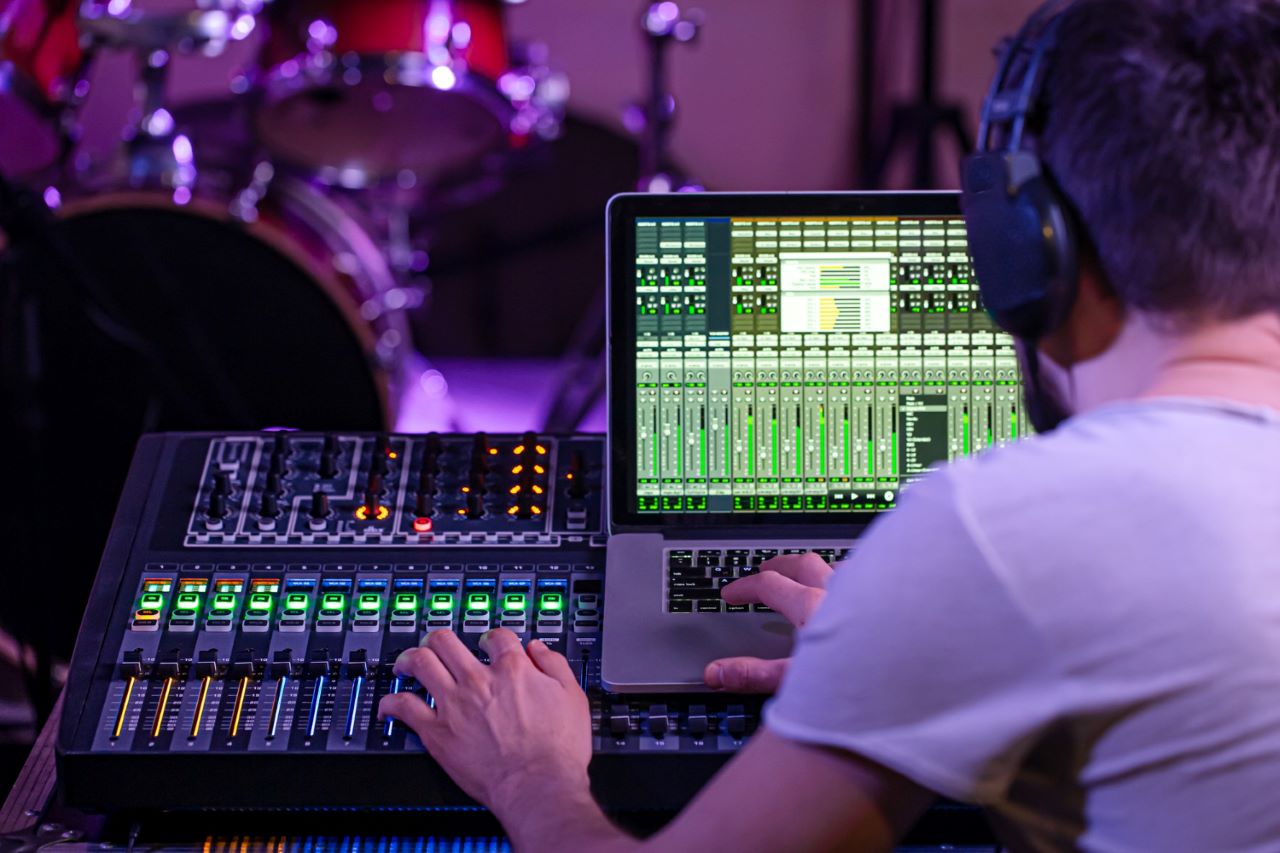
Image by pvproductions on Freepik
Audio interfaces play a pivotal role in determining the quality of recordings. They house the AD/DA (Analog to Digital, Digital to Analog) converters responsible for translating your instrument or voice into digital data and back.
High-quality audio interfaces generally possess superior converters that capture and reproduce sound more accurately and cleanly. They also have better preamps for microphones, ensuring clarity and minimizing noise. Thus, investing in a good audio interface can elevate your recording quality from amateur to professional.
Is Latency A Big Issue When Recording?
Latency refers to the delay between playing/singing a note and hearing it back through your headphones or speakers. In recording scenarios, especially when layering tracks or recording alongside pre-recorded tracks, latency can be incredibly disruptive. It can throw off timing, disrupt rhythm, and make real-time monitoring a challenge.
While most modern audio interfaces boast minimal latency, especially those with Thunderbolt connections, it’s always a crucial factor to consider. A latency below 10ms is usually considered acceptable, but with high-end interfaces, you can expect even lower figures, ensuring seamless recording experiences.
Conclusion
The landscape of audio recording has evolved tremendously over the past few decades, with advancements in technology continuously redefining the boundaries of what’s possible. Among these innovations, Thunderbolt audio interfaces have carved a niche for themselves, offering unparalleled speed and consistency for today’s demanding recording scenarios.
For users of Logic Pro X, these interfaces are not just tools but a pathway to achieving sonic excellence. Through this guide, we’ve endeavored to present a holistic view of these remarkable devices, highlighting their importance and unique features and introducing some of the market leaders.
As with any piece of technology, it’s crucial to evaluate your specific needs, budget, and aspirations before making a choice. Remember, in the world of audio, the pursuit is always for clarity, depth, and authenticity. Invest in equipment that brings your sonic vision to life, and let the melodies flow!